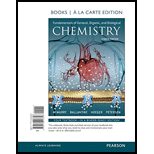
Concept explainers
(a)
Interpretation:
Reason for side chain in valine is nonpolar and in serine is polar has to be identified.
Concept introduction:
Many amino acids are linked together through amide bonds to form a biologically large molecule known to be proteins.
Amino acid had both amino functional group and carboxyl functional group in a molecule.
Amino functional group is
The amino acids are further classified into polar and non-polar amino acid.
Polar amino acid are those that contain groups that are either charged at physiological
Nonpolar amino acids are those with alkyl hydrophobic group which cannot enter in hydrogen bonding.
(b)
Interpretation:
Amino acid that has hydrophilic and hydrophobic side chain has to be identified.
Concept introduction:
Many amino acids are linked together through amide bonds to form a biologically large molecule known to be proteins.
Amino acid had both amino functional group and carboxyl functional group in a molecule.
Amino functional group is
The non-polar side chain are again classified into hydrophobic (water hating) and hydrophilic (water loving).
Want to see the full answer?
Check out a sample textbook solution
Chapter 18 Solutions
Fundamentals of General, Organic, and Biological Chemistry, Books a la Carte Edition (8th Edition)
- Valine is an amino acid with a nonpolar side chain and serine is one with a polar side chain. Draw the two amino acids.(a) Why is the side chain for valine nonpolar, whereas the side chain for serineis polar?(b) Which amino acid has a hydrophilic side chain and which has a hydrophobic sidechain?arrow_forwardWhat is the approximate molecular weight of a protein with 682 amino acid residues in a single polypeptide chain?arrow_forwardGiven this short polypeptide: Met-Ala-Gly-Ser A) Which is the amino terminal amino acid? B) How many amino acids are in this polypeptide? C) How many peptide bonds are in this polypeptide? D) Which amino acid has the smallest side chain? E) Which amino acid contains sulfur?arrow_forward
- Which R group would most likely be found in a hydrophobic area of the tertiary structure of a globular protein?arrow_forwardAre all the amino-acids soluble in water? Explain why?arrow_forwardWould the presence of a chiral center in an amino acid side chain affect the formation of a peptide bond?arrow_forward
- Would the peptide group be planar if the amino group of amino acids was bonded to the β carbon of the amino acid, rather than to the α carbon?arrow_forwardWhy is the ionic bond between, say, the side chain of lysine and the side chain of glutamic acid stronger in the hydrophobic interior of a protein than in aqueous solvent (water)?arrow_forwarda. which amino acid can form a covalent bond with its side chain? b. which amino acid can contribute to protein tertiary and quarternary structure by forming a covalent bond?arrow_forward
- What is the structural flat representation of an amino acid molecule?arrow_forwardA portion of a polypeptide chain contains the following sequence of amino acids: (-Met, -Leu, -Ala, -Cys, -Asp-) a.) Which amino acid can form a disulfide bond? b.) Which amino acids are likely to make the polypeptide more soluble in water? c.) Which amino acids are likely to make the polypeptide less soluble in water? d.) How does the primary structure of a protein affect its tertiary structure?arrow_forwardDraw the structures of the 20 standard amino acids and give their one- and three letter abbreviations.arrow_forward
 BiochemistryBiochemistryISBN:9781319114671Author:Lubert Stryer, Jeremy M. Berg, John L. Tymoczko, Gregory J. Gatto Jr.Publisher:W. H. Freeman
BiochemistryBiochemistryISBN:9781319114671Author:Lubert Stryer, Jeremy M. Berg, John L. Tymoczko, Gregory J. Gatto Jr.Publisher:W. H. Freeman Lehninger Principles of BiochemistryBiochemistryISBN:9781464126116Author:David L. Nelson, Michael M. CoxPublisher:W. H. Freeman
Lehninger Principles of BiochemistryBiochemistryISBN:9781464126116Author:David L. Nelson, Michael M. CoxPublisher:W. H. Freeman Fundamentals of Biochemistry: Life at the Molecul...BiochemistryISBN:9781118918401Author:Donald Voet, Judith G. Voet, Charlotte W. PrattPublisher:WILEY
Fundamentals of Biochemistry: Life at the Molecul...BiochemistryISBN:9781118918401Author:Donald Voet, Judith G. Voet, Charlotte W. PrattPublisher:WILEY BiochemistryBiochemistryISBN:9781305961135Author:Mary K. Campbell, Shawn O. Farrell, Owen M. McDougalPublisher:Cengage Learning
BiochemistryBiochemistryISBN:9781305961135Author:Mary K. Campbell, Shawn O. Farrell, Owen M. McDougalPublisher:Cengage Learning BiochemistryBiochemistryISBN:9781305577206Author:Reginald H. Garrett, Charles M. GrishamPublisher:Cengage Learning
BiochemistryBiochemistryISBN:9781305577206Author:Reginald H. Garrett, Charles M. GrishamPublisher:Cengage Learning Fundamentals of General, Organic, and Biological ...BiochemistryISBN:9780134015187Author:John E. McMurry, David S. Ballantine, Carl A. Hoeger, Virginia E. PetersonPublisher:PEARSON
Fundamentals of General, Organic, and Biological ...BiochemistryISBN:9780134015187Author:John E. McMurry, David S. Ballantine, Carl A. Hoeger, Virginia E. PetersonPublisher:PEARSON





